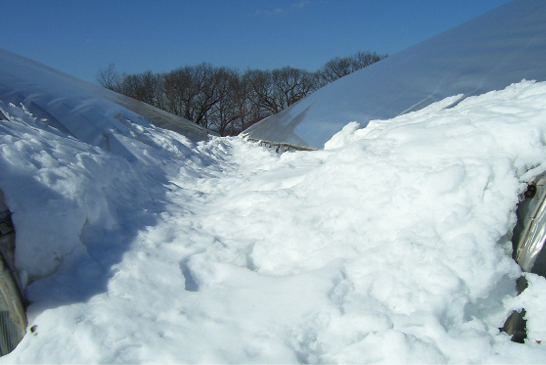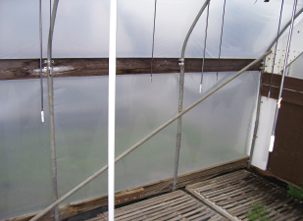
With the hurricanes along the East Coast and in the Northwest this past fall, and the prediction of heavy snow in some areas this winter, growers frequently question the load that their greenhouses will withstand.
All buildings, including greenhouses, headhouses and storage buildings are affected by external and internal loads. These loads are transferred through the frame members and foundation to the ground. Loads are commonly classified as dead loads, live loads, snow loads, wind loads and in some locations, earthquake loads.
Dead loads
Dead loads are gravity loads that are constant in magnitude throughout the life of the building. They include the walls, roof, glazing and fixed equipment. Fans, suspended heaters and overhead piping for water or heat are also considered a dead load, as they are permanently attached to the structure. Long-term crops, such as tomatoes or cucumbers that are suspended from the trusses, are frequently identified as a dead load. Short-term crops, such as hanging baskets, are normally considered a live load.
Values for wind uplift must not exceed the dead load of the structure, otherwise the structure could be lifted out of the ground. This can occur occasionally to hoophouses that only have the pipes driven 18 to 24 inches into the soil. These structures weigh very little, and the hoop shape acts like an airplane wing that tends to create uplift when the wind passes over it.
Live loads
Live loads are more difficult to calculate, as they can change. One common live load is a maintenance crew repairing glazing on the roof. Another is a trolley conveyor that moves plants into the greenhouse. The carrier full of plants weighs 200 to 300 pounds. This is a concentrated load that moves as the conveyor is pushed along. The National Greenhouse Manufacturers Association (NGMA) design guidelines recommend that purlins, rafters and trusses be designed to support a minimum concentrated load of 100 pounds at midspan.
Short-term plant loads are considered live loads. NGMA recommends that these be limited to a maximum of 15 pounds/square foot (psf). A crop of 10-inch hanging baskets could add from 3 to 5 psf.
Wind loads
Loading from the wind can come from any direction, but is usually considered to act in a horizontal direction against the walls. Basic wind speeds for design are 90 miles/hour (mph) for most of the U.S., except the West Coast — which uses 85 mph — and the east and southeast coasts where hurricanes are common. There, loads vary from 90 to 150 mph depending on the distance from the coastline.
The basic wind speed is adjusted for factors such as site exposure; height and shape of the building; roof slope; and use factor. Greenhouses and sales buildings that are open to the public have a higher use factor than a production greenhouse. The above factors are applied to the wind velocity to get a wind load. Structural member size and resistance to overturning are then calculated.
During heavy wind conditions, doors and vents should be closed to reduce the double effect of external wind pressure and the force of the wind that gets in through the openings.

Snow loads
Snow loads vary considerable from 0 psf along the south coast of the U.S. to more than 100 psf in northern Maine and in some of the higher mountain areas. Local building codes specify the design snow load.
Snow can be light and fluffy with a water equivalent of 12 inches equal to 1 inch of rain. It can also be wet and heavy with 3 to 4 inches, equal to the weight of 1 inch of rain. Snow having a 1-inch rainwater equivalent will load a structure with 5.2 psf. This amounts to about 6.5 tons on a 25 x 96-foot greenhouse.
Design snow loads are usually adjusted to consider building exposure, roof slope, heat loss through the roof and the type of occupancy. As the heat loss through the glazing on a greenhouse is high, the design usually considers that most of the snow will melt or slide off.
Drifting snow causes unbalanced loads that may collapse greenhouses. Two to four times normal loads may occur where drifts or sliding snow build up. This is especially true in ranges of several hoophouses where they are placed side by side. It can also occur on the leeward bays of a gutter-connected range. A space of at least 10 feet should be left between freestanding greenhouses to provide space for the snow that slides off. If there is not adequate space, sidewalls may be crushed in.
Other considerations
In practice, combinations of loads are used as several types of loading may occur at the same time. For example, there may be a high wind associated with a snowstorm.
In some areas of the country, earthquake loads may have to be considered. Production greenhouses are usually exempt, as they have limited human occupancy.
Today, most manufacturers provide a structural analysis for their greenhouses. This may be required to obtain a building permit and insures that the greenhouse will handle the forces of nature without problems.

Explore the January 2017 Issue
Check out more from this issue and find you next story to read.
Latest from Greenhouse Management
- CIOPORA appoints Micaela Filippo as vice secretary-general
- Passion grows progress
- Registration opens for Darwin Perennials Day
- U.S. Department of Labor finalizes farmworker protection rule
- Azo Root is now available from Harrell’s
- Bidens ferulifolia Blazing Glory
- Rob Hanifin joins Ridder North America as product specialist for climate screens
- The importance of measuring light





